Power Source Importance Assessment Based on Load Importance and New Energy Uncertainty
Abstract
:1. Introduction
2. Load Importance Indicator Assessment Methodology
2.1. Load Importance Indicators
2.1.1. Load Topology Factor
2.1.2. Load Outage Loss Indicators
2.1.3. Load Regulation Capacity Indicators
2.2. Load Importance Evaluation Method Based on Ideal Solution Method
3. Power Source Importance Assessment Based on Load Importance and New Energy Uncertainty
3.1. New Energy System Tidal Current Calculation Based on Point Estimation Method
3.1.1. New Energy Output Uncertainty Model
- (1)
- Wind Power Output Model
- (2)
- PV power generation output model
3.1.2. Point Estimation Method
3.1.3. Power Flow Calculation Steps Based on the Point Estimation Method
3.2. Power Importance Assessment Based on Load Importance and Power Characteristics
3.2.1. Power Supply Composite Supply Factor Indicator
3.2.2. Power Supply Importance Indicators for Different Power Supply Characteristics
- (1)
- Wind farm self-characteristic index
- (2)
- The photovoltaic power station self-characteristic index
- (3)
- The conventional power supply self-characteristic index
3.3. Evaluation Method of Source-Load Importance Index Based on Ideal Algorithm
4. Example Analysis
4.1. Load Importance Assessment
4.2. Power Supply Importance Assessment
5. Conclusions
- (1)
- The load importance assessment method takes a comprehensive approach, considering various factors such as the node’s location characteristics, the load’s sensitivity to power outages, and its ability to enhance the coordination capacity of the power grid. It treats the load as a part of the load area, accounting for the types of users within it and calculating the outage losses for the entire load area, considering the varying outage sensitivity of different users. This approach is more realistic than solely assessing based on load power. Additionally, the method also takes into account the adjustable ability of the load, highlighting the significant role of loads in participating in the coordination of the power grid source network.
- (2)
- The way of separately evaluating the importance of different kinds of power supply can fully evaluate the importance of power supply from the perspective of power supply and the characteristics of the power supply itself. Considering the influence of load importance and taking the comprehensive power supply coefficient as the assessment index, it can be concluded that the important power supply is more capable of guaranteeing the power supply of important loads.
- (3)
- This method plays an important role in the safe and stable operation of the power system. At the system network planning level, the load importance assessment helps construct a backbone network framework that prioritizes crucial loads and essential power sources while minimizing the number of lines required. By protecting this framework, we ensure the continuous power supply to important loads and reduce the risk of chain failures. This approach aligns with the objective of safeguarding the power system’s stability and resilience, thereby enhancing its ability to withstand potential disruptions and maintain a reliable power supply to critical loads.
Author Contributions
Funding
Institutional Review Board Statement
Informed Consent Statement
Data Availability Statement
Conflicts of Interest
References
- Chao, Y.; Heyang, S.; Tong, L. Coupled Model and Node Importance Evaluation of Electric Power Cyber-Physical Systems Considering Carbon Power Flow. Energies 2022, 15, 8223. [Google Scholar] [CrossRef]
- Wang, Y.; Zou, Y.; Huang, L.; Li, K. Key Nodes Identification of Power Grid Considering Local and Global Characteristics. Chin. J. Comput. Phys. 2018, 35, 119–126. [Google Scholar]
- Geng, J.Q.; Piao, X.F.; Qu, Y.B.; Song, H.H. Method for Finding the Important Nodes of an Electrical Power System Based on Weighted-SALSA Algorithm. IET Gener. Transm. Distrib. 2019, 13, 4933–4941. [Google Scholar] [CrossRef]
- Zou, Y.; Tan, S.; Liu, X.; Zhang, S.; Li, H. Power GridBased on Subnet Partition Key Node Recognition. Comput. Phys. 2013. [Google Scholar]
- Zhao, Y.; Han, C.; Lin, Z.; Yang, L.; Wang, L.; Huang, J. Optimization Strategy of Two-Stage Core Backbone Grid of Power System with Renewable Energy. Power Grid Technol. 2019, 43, 371–386. [Google Scholar]
- Chen, B.; Wang, H.; Cao, X. Optimization of Load Recovery in Late Stage of Grid Reconstruction Considering Load Fuzzy Uncertainty: Automation of Electric Power Systems. Autom. Electr. Power Syst. 2016, 40, 6–12. [Google Scholar]
- Chen, P. Elastic Load Resource Aggregation and Regulate Potential Forecast Model Research; North China Electric Power University: Beijing, China, 2021. [Google Scholar]
- Anderson, J. North American Power Futures Trading Volume on Nodal Exchange Jumps in April. Platts Megawatt Dly. 2019, 24, 2–3. [Google Scholar]
- Banner, K.M.; Irvine, K.M.; Rodhouse, T.J. Statistical Power of Dynamic Occupancy Models to Identify Temporal Change: Informing the North American Bat Monitoring Program. Ecol. Indic. 2019, 105, 166–176. [Google Scholar] [CrossRef]
- Chen, Q. The Assessment of the Outage Cost of Customersand the Cost-Effective of the Reliability of Distribution Network; Northeastern University: Boston, MA, USA, 2015. [Google Scholar]
- Wang, Y.; Zhou, X.; Liu, H.; Chen, X.; Yan, Z.; Li, D.; Liu, C.; Wang, J. Evaluation of the Maturity of Urban Energy Internet Development Based on AHP-Entropy Weight Method and Improved TOPSIS. Energies 2023, 16, 5151. [Google Scholar] [CrossRef]
- Lin, G.; Mo, T.; Ye, X. Critical Node Identification of Power Networks Based on TOPSIS and CRITIC Methods. High Volt. Eng. 2018, 44, 3383–3389. [Google Scholar]
- Chen, C.; Rong, Y.; Ji, C. Speaker Verification Method Based on Deep Information Divergence Maximization. J. Commun. 2021, 42, 231–237. [Google Scholar]
- Wang, W.; Chen, K.; Bai, Y. Comparative Study on Wind Speed Distribution Models of Hohhot Suburb Based on Measured Data. Acta Energ. Solaris Sin. 2021, 42, 370–376. [Google Scholar]
- Fernandez-Jimenez, L.A.; Monteiro, C.; Ramirez-Rosado, I.J. Short-Term Probabilistic Forecasting Models Using Beta Distributions for Photovoltaic Plants. Energy Rep. 2023, 9, 495–502. [Google Scholar] [CrossRef]
- Cheng, Z.-L.; Li, H.-K.; Li, F.-J.; Zeng, X.-Z. Multi Objective Optimal Power Flow Based on Wind Power Photovoltage Output Uncertainty. Control Theory Appl. 2021, 40, 11–16. [Google Scholar]
- Xiao, Q.; Wu, L.; Chen, C. Probabilistic Power Flow Computation Using Nested Point Estimate Method. IET Gener. Transm. Distrib. 2021, 16, 1064–1082. [Google Scholar] [CrossRef]
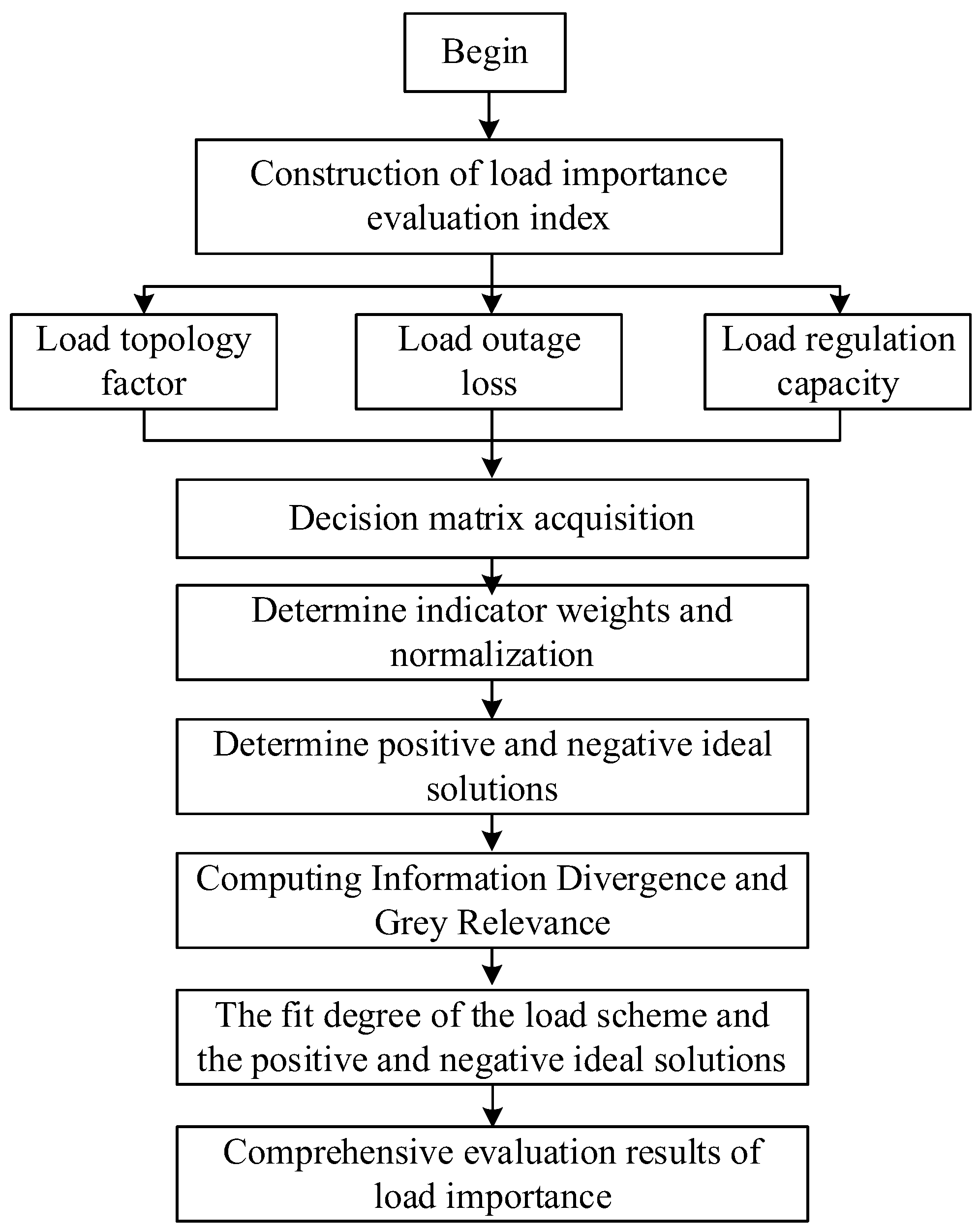
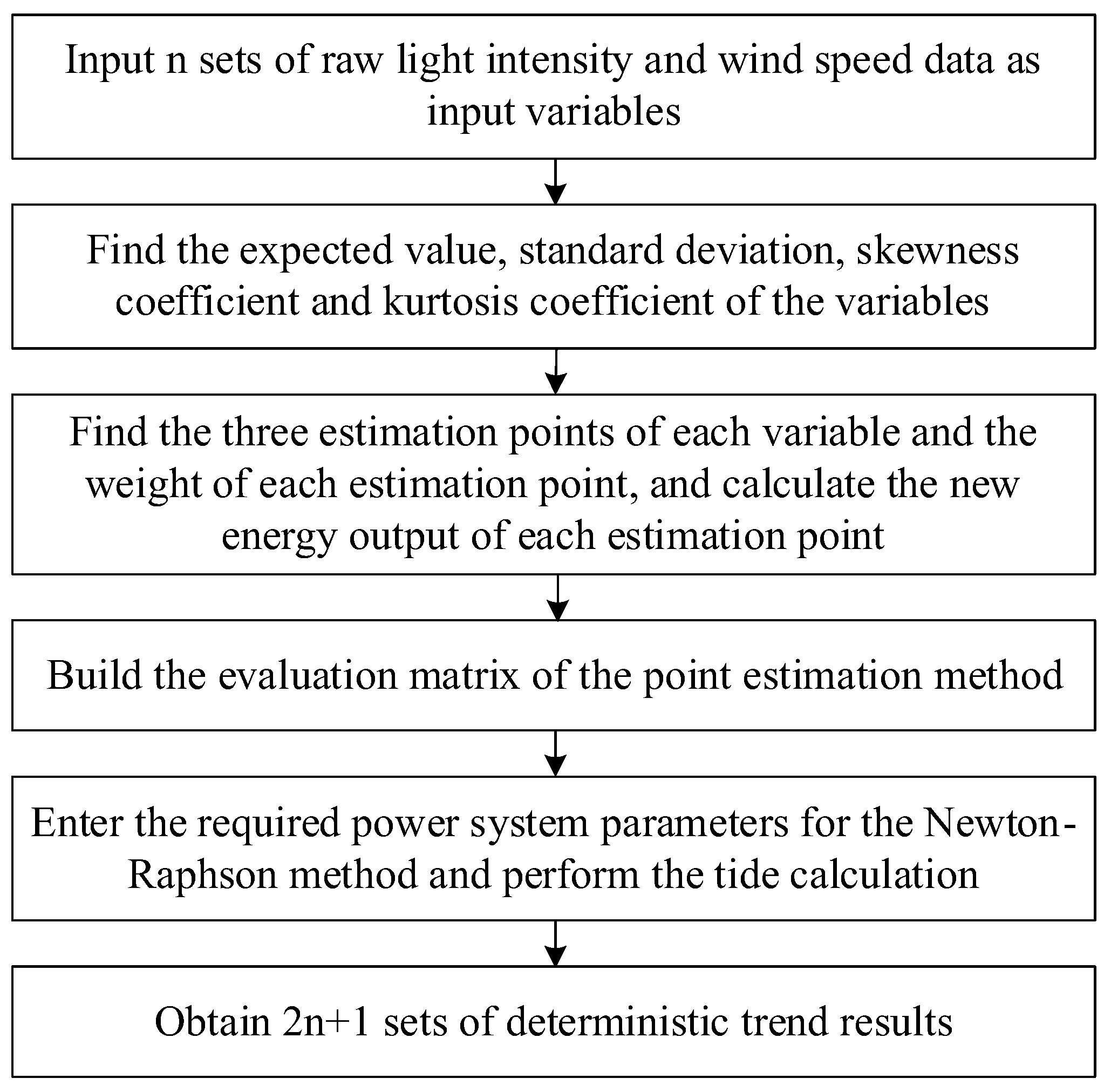
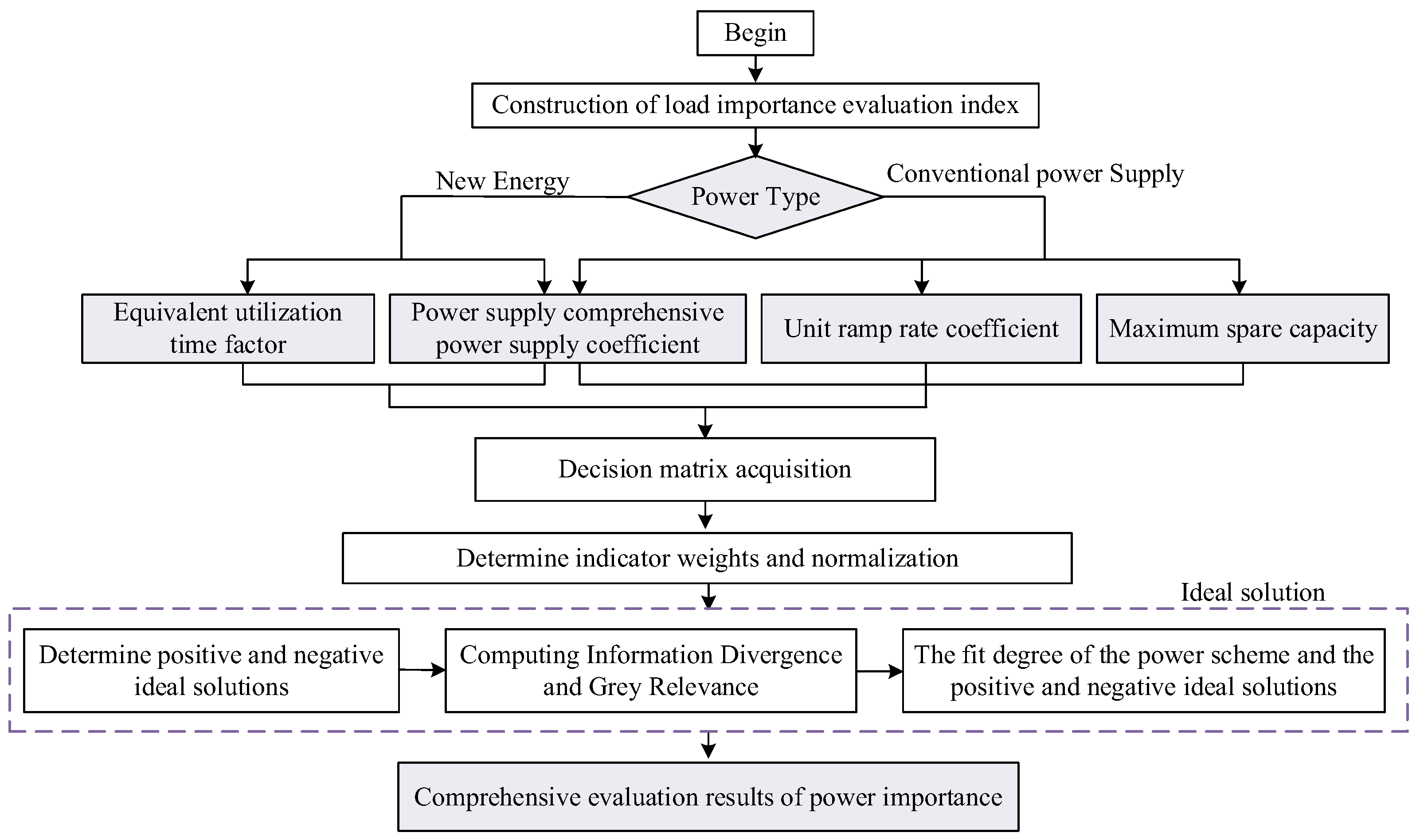

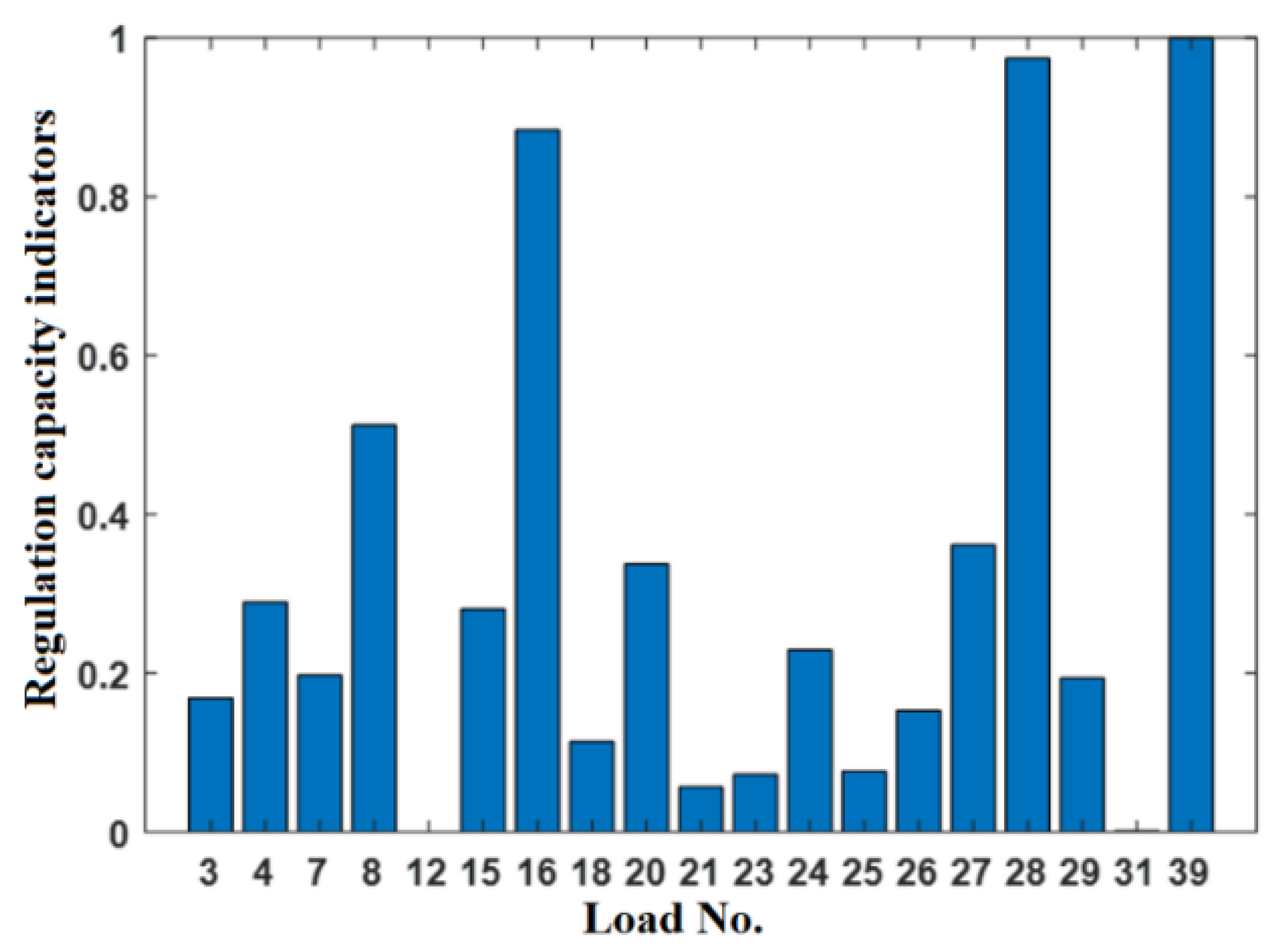
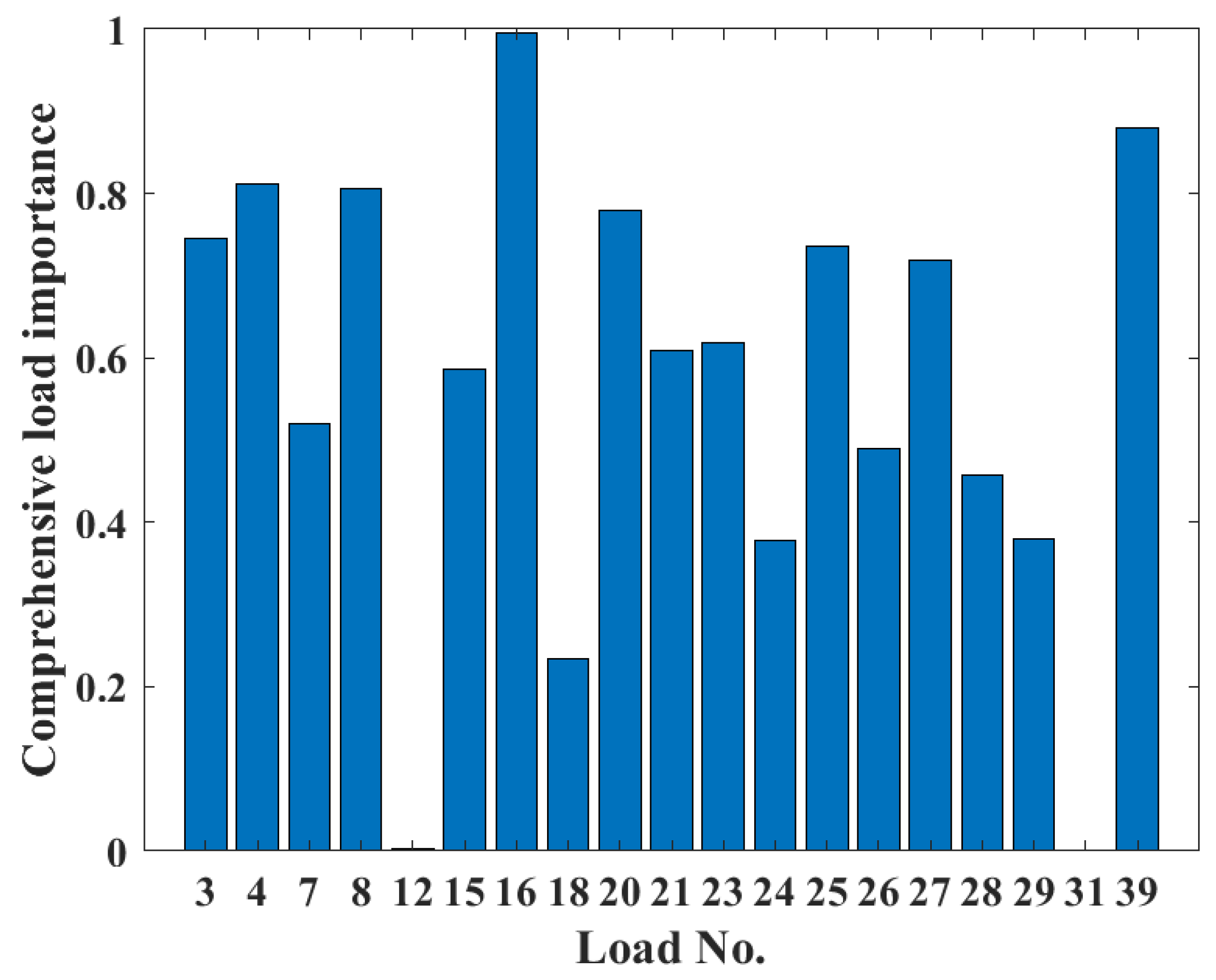
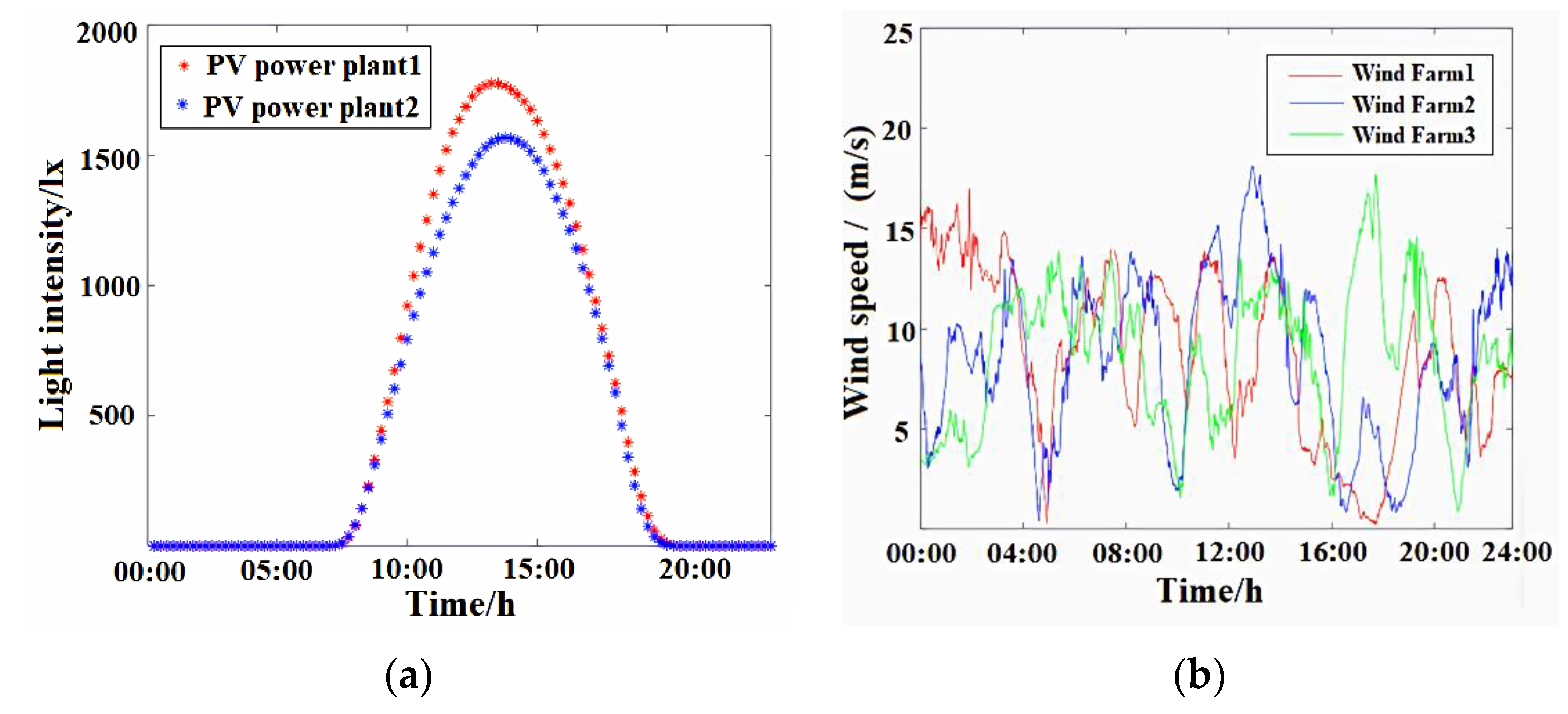
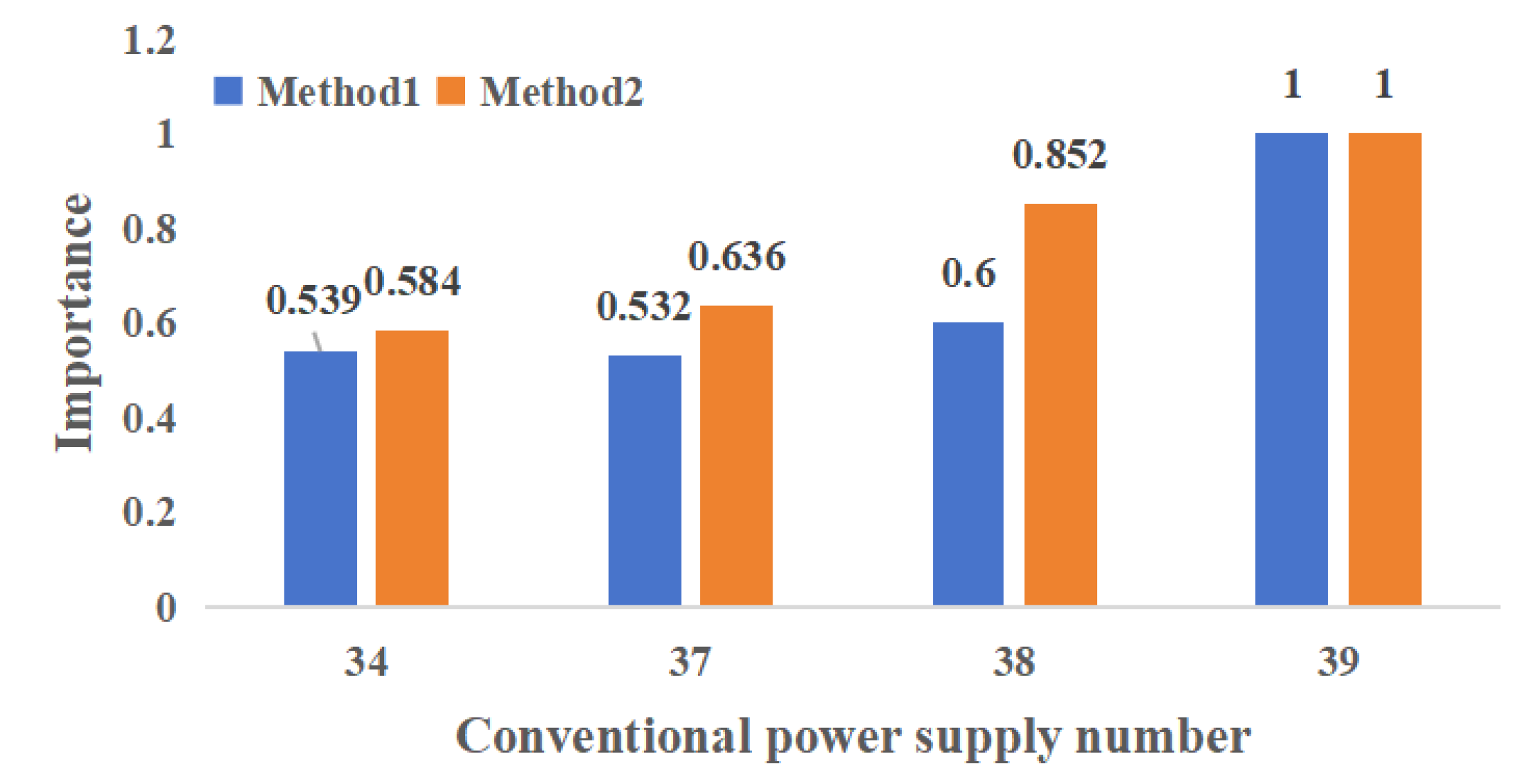

| Load No. | Load Topology Factor | Load Outage Loss | Load Regulation Capacity |
|---|---|---|---|
| 3 | 0.702 | 3646.572 | 3.210 |
| 4 | 0.700 | 6558.973 | 5.412 |
| 7 | 0.325 | 5253.125 | 3.732 |
| 8 | 0.489 | 8684.986 | 9.490 |
| 12 | 0.354 | 103.588 | 0.120 |
| 15 | 0.589 | 4123.819 | 5.252 |
| 16 | 1 | 2913.223 | 16.291 |
| 18 | 0.569 | 3501.365 | 2.200 |
| 20 | 0.476 | 9633.306 | 6.292 |
| 21 | 0.539 | 3349.172 | 1.152 |
| 23 | 0.508 | 2946.491 | 1.444 |
| 24 | 0.532 | 4225.990 | 4.313 |
| 25 | 0.636 | 3109.785 | 1.515 |
| 26 | 0.760 | 5753.872 | 2.914 |
| 27 | 0.494 | 6153.832 | 6.731 |
| 28 | 0.337 | 6062.701 | 17.938 |
| 29 | 0.479 | 3112.751 | 3.659 |
| 31 | 0.316 | 117.652 | 0.148 |
| 39 | 0.383 | 14,606.531 | 18.409 |
| Rank | Top 10 Load Outage Losses | Top 10 Load Power Loads |
|---|---|---|
| 1 | 39 | 39 |
| 2 | 20 | 20 |
| 3 | 21 | 8 |
| 4 | 8 | 4 |
| 5 | 7 | 16 |
| 6 | 27 | 3 |
| 7 | 23 | 15 |
| 8 | 4 | 24 |
| 9 | 25 | 29 |
| 10 | 3 | 27 |
| Indicator | Load Topology Factor | Load Outage Loss | Load Regulation Capacity |
|---|---|---|---|
| Combined weights | 0.330 | 0.432 | 0.238 |
| Rank | Load Importance of This Paper | Top 10 Ranking of Importance of This Article | Top 10 Ranking of Importance in Ref. [5] | Top 10 Load Topology | Top 10 Load Outage Losses | Top 10 Load Regulation Capacity |
|---|---|---|---|---|---|---|
| 1 | 1 | 16 | 16 | 16 | 39 | 39 |
| 2 | 0.875 | 39 | 25 | 26 | 20 | 28 |
| 3 | 0.810 | 4 | 21 | 25 | 21 | 16 |
| 4 | 0.802 | 8 | 4 | 3 | 8 | 8 |
| 5 | 0.772 | 20 | 3 | 4 | 7 | 27 |
| 6 | 0.741 | 3 | 26 | 23 | 27 | 20 |
| 7 | 0.735 | 25 | 29 | 29 | 23 | 4 |
| 8 | 0.715 | 27 | 39 | 20 | 4 | 15 |
| 9 | 0.615 | 23 | 23 | 21 | 25 | 24 |
| 10 | 0.608 | 21 | 20 | 24 | 3 | 7 |
| Power No. | Type | Rated Capacity |
|---|---|---|
| 30 | Wind | 250 |
| 32 | Wind | 650 |
| 33 | Wind | 632 |
| 35 | Solar | 650 |
| 36 | Solar | 560 |
| Power No. | Minimum Technical Output | Rated Capacity | Climb Rate |
|---|---|---|---|
| 31 | 400 | 1100 | 350 |
| 34 | 158 | 508 | 200 |
| 37 | 150 | 540 | 225 |
| 38 | 430 | 830 | 300 |
| 39 | 500 | 1000 | 325 |
| New Energy Field | 1 | 2 | 3 | 4 | 5 |
|---|---|---|---|---|---|
| xi,1 | 13.91 | 13.51 | 15.81 | 1654.75 | 1437.21 |
| xi,2 | 2.85 | 2.83 | 2.79 | 40.91 | 44.69 |
| xi,3 | 8.65 | 8.06 | 9.25 | 464.67 | 462.61 |
| Group | 1 | 2 | 3 | 4 | 5 | 6 | 7 | 8 | 9 | 10 | 11 |
|---|---|---|---|---|---|---|---|---|---|---|---|
| Weight | 0.049 | 0.038 | 0.037 | 0.021 | 0.021 | 0.044 | 0.039 | 0.038 | 0.067 | 0.067 | 0.579 |
| Power No. | Combined Power Supply Actor | Maximum Spare Capacity | Climb Rate Coefficient | Conventional Power Importance | Importance of Substituting Power Supply Capacity for Integrated Power Supply Factor |
|---|---|---|---|---|---|
| 34 | 390.984 | 350 | 0.394 | 0.539 | 0.584 |
| 37 | 361.583 | 390 | 0.417 | 0.532 | 0.636 |
| 38 | 418.569 | 400 | 0.361 | 0.6 | 0.852 |
| 39 | 873.018 | 500 | 0.325 | 1 | 1 |
| Power No. | Combined Power Supply Factor | Equivalent Utilization Time Factor | Wind Farm Importance | Importance of Substituting Power Supply Capacity for Integrated Power Supply Factor |
|---|---|---|---|---|
| 30 | 114.971 | 0.582 | 0.389 | 0.496 |
| 32 | 281.450 | 0.528 | 0.868 | 1 |
| 33 | 388.284 | 0.624 | 1 | 0.990 |
| Power No. | Combined Power Supply Factor | Equivalent Utilization Time Factor | PV Power Plant Importance | Importance of Substituting Power Supply Capacity for Integrated Power Supply Factor |
|---|---|---|---|---|
| 35 | 111.563 | 0.356 | 0.734 | 1 |
| 36 | 137.167 | 0.362 | 1 | 0.742 |
Disclaimer/Publisher’s Note: The statements, opinions and data contained in all publications are solely those of the individual author(s) and contributor(s) and not of MDPI and/or the editor(s). MDPI and/or the editor(s) disclaim responsibility for any injury to people or property resulting from any ideas, methods, instructions or products referred to in the content. |
© 2023 by the authors. Licensee MDPI, Basel, Switzerland. This article is an open access article distributed under the terms and conditions of the Creative Commons Attribution (CC BY) license (https://creativecommons.org/licenses/by/4.0/).
Share and Cite
Zhao, J.; Zhang, Y.; Dong, X.; Wu, Y.; Zeng, H.; Duan, Q.; Zhang, M. Power Source Importance Assessment Based on Load Importance and New Energy Uncertainty. Sustainability 2023, 15, 12941. https://doi.org/10.3390/su151712941
Zhao J, Zhang Y, Dong X, Wu Y, Zeng H, Duan Q, Zhang M. Power Source Importance Assessment Based on Load Importance and New Energy Uncertainty. Sustainability. 2023; 15(17):12941. https://doi.org/10.3390/su151712941
Chicago/Turabian StyleZhao, Jie, Yiyang Zhang, Xuzhu Dong, Yunzhao Wu, Haiyan Zeng, Qing Duan, and Mingcheng Zhang. 2023. "Power Source Importance Assessment Based on Load Importance and New Energy Uncertainty" Sustainability 15, no. 17: 12941. https://doi.org/10.3390/su151712941
APA StyleZhao, J., Zhang, Y., Dong, X., Wu, Y., Zeng, H., Duan, Q., & Zhang, M. (2023). Power Source Importance Assessment Based on Load Importance and New Energy Uncertainty. Sustainability, 15(17), 12941. https://doi.org/10.3390/su151712941






